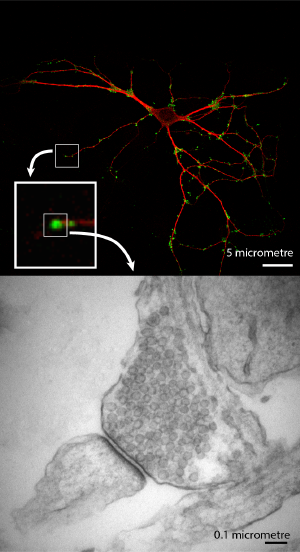Jan van Weering
Assistant Professor
My research group aims to uncover the molecular mechanisms involved in membrane trafficking and recycling in synapses at nanometer resolution. We study of the transport, docking and fusion of secretory vesicles and the sorting of critical synaptic proteins through endosomes. Endosome recycling is important for the maintenance of basic neurotransmission, but it is also highly dysregulated in neurogenerative diseases such as Alzheimer’s disease. We aim to understand the causal relation between disease progression and the disruption of the endolysosomal pathway.

Research Area
Our research group aims to uncover the molecular mechanisms involved in the membrane trafficking pathways, utilized by secretory vesicles at nanometer resolution.
We coordinate the Electron Microscopy Facility at the VU campus . There, we utilize advanced electron microscopy techniques to study these membrane transport steps in nanoscale resolution. This is combined with a wide variety of fluorescence microscopy techniques to investigate dynamic processes in real time, both in living neurons and neuroendocrine cells.
Technical Expertise
– immuno-electron microscopy
– cryo-electron microscopy
– electron tomography
– correlative light and electron microscopy
– live cell imaging (TIRF, pHluorin)
– superresolution light microscopy (STORM)
– confocal microscopy
These methods are also available for all researchers of the VU campus region and beyond through our EM facility.
Support
We are supported by Alzheimer Nederland and the Alzheimer Association.
Selected Publications
Vazquez-Sanchez S, Gonzalez-Lozano MA, Walfenzao A, Li KW, van Weering JRT. The endosomal protein sorting nexin 4 is a synaptic protein. Sci Rep. 2020 Oct 26;10(1):18239.
Gowrisankaran S, Houy S, Del Castillo JGP, Steubler V, Gelker M, Kroll J, Pinheiro PS, Schwitters D, Halbsgut N, Pechstein A, van Weering JRT, Maritzen T, Haucke V, Raimundo N, Sørensen JB, Milosevic I.
Endophilin-A coordinates priming and fusion of neurosecretory vesicles via intersectin. Nat Commun. 2020 Mar 9;11(1):1266.
Pons-Vizcarra M, Kurps J, Tawfik B, Sørensen, JB, van Weering, JRT and Verhage, M MUNC18-1 regulates submembrane F-actin network, independently of syntaxin1 targeting, via hydrophobicity in β-sheet 10. J Cell Sci. 2019 Dec 2;132(23). pii: jcs234674.
Persoon CM, Hoogstraaten R, van Weering JRT, Kaeser PS, Toonen RF and Verhage M. The Rab3-RIM pathway is essential for neuropeptide release. Neuron. 2019 Dec 18;104(6):1065-1080.e12.
Wiersma V, van Ziel, AM, Vazquez-Sanchez S, Nolle A, Berenjeno-Correa E, Bonaterra-Pastra A, Clavaguera F, Musters RJP, van Weering JRT, Verhage M, Scheper W. Granulovacuolar degeneration bodies are neuron-selective lysosomal structures induced by intracellular tau pathology. Acta Neuropathol. 2019 138, p943–970
Vazquez-Sanchez S, Bobeldijk S, Dekker MP, van Keimpema L, van Weering JRT. VPS35 depletion does not impair presynaptic structure and function. Sci Rep. 2018 Feb 14;8(1):2996.
Meijer M, Dörr B, Lammertse HC, Blithikioti C, van Weering JRT, Toonen RF, Söllner TH, Verhage M. Tyrosine phosphorylation of Munc18-1 inhibits synaptic transmission by preventing SNARE assembly. EMBO J. 2018 Jan 17;37(2):300-320.
van Weering, J.R.T., Sessions, R.B., Traer, C.J., Kloer D.P., Bhatia V.K., Stamou D., Hurley, J.H. and Cullen P.J. Molecular basis for SNX-BAR-mediated assembly of distinct endosomal sorting tubules. EMBO J (2012), vol 31 (23) pp. 4466-80
van Weering, J.R.T., Verkade, P., Cullen, P.J. SNX-BAR-mediated endosome tubulation is coordinated with endosome maturation. Traffic (2012), vol. 13 (1) pp. 94-107